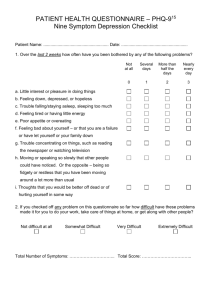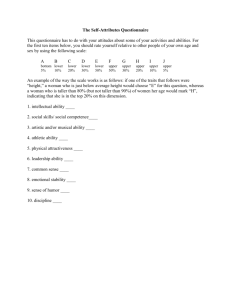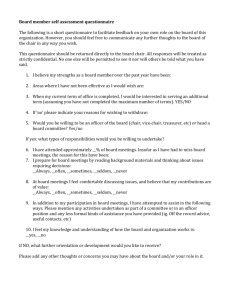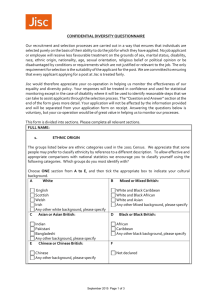Supplementary Table 1 | Methods of clinical phenotyping
advertisement
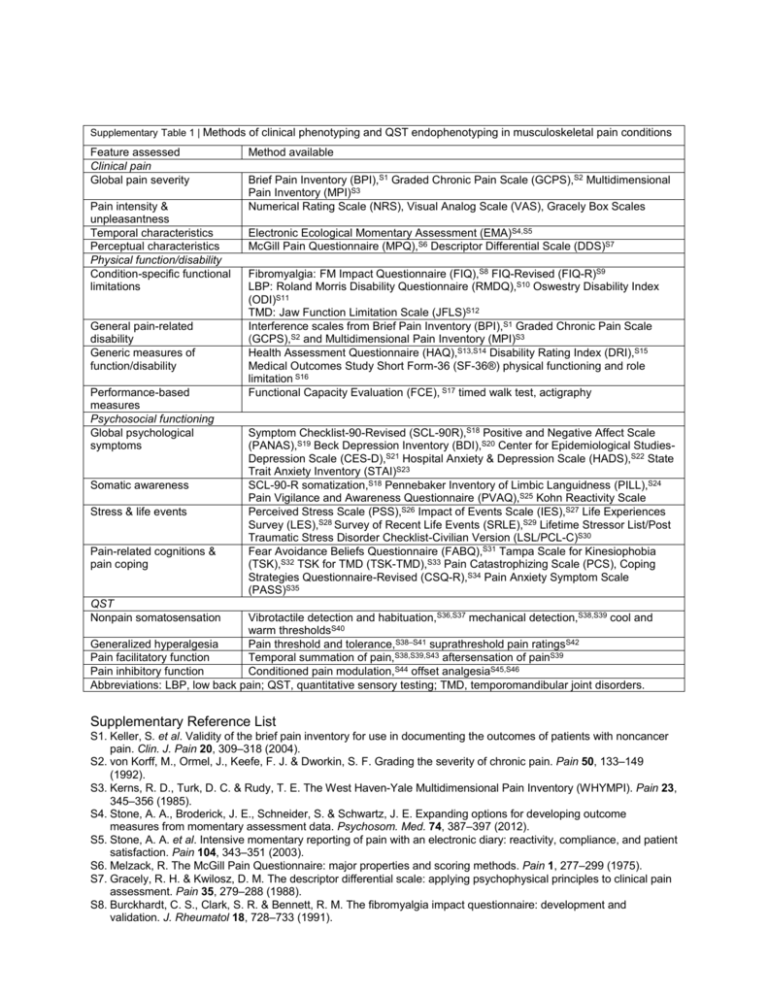
Supplementary Table 1 | Methods of clinical phenotyping and QST endophenotyping in musculoskeletal pain conditions Feature assessed Clinical pain Global pain severity Pain intensity & unpleasantness Temporal characteristics Perceptual characteristics Physical function/disability Condition-specific functional limitations General pain-related disability Generic measures of function/disability Performance-based measures Psychosocial functioning Global psychological symptoms Somatic awareness Stress & life events Pain-related cognitions & pain coping Method available Brief Pain Inventory (BPI),S1 Graded Chronic Pain Scale (GCPS),S2 Multidimensional Pain Inventory (MPI)S3 Numerical Rating Scale (NRS), Visual Analog Scale (VAS), Gracely Box Scales Electronic Ecological Momentary Assessment (EMA)S4,S5 McGill Pain Questionnaire (MPQ),S6 Descriptor Differential Scale (DDS)S7 Fibromyalgia: FM Impact Questionnaire (FIQ),S8 FIQ-Revised (FIQ-R)S9 LBP: Roland Morris Disability Questionnaire (RMDQ),S10 Oswestry Disability Index (ODI)S11 TMD: Jaw Function Limitation Scale (JFLS)S12 Interference scales from Brief Pain Inventory (BPI),S1 Graded Chronic Pain Scale (GCPS),S2 and Multidimensional Pain Inventory (MPI)S3 Health Assessment Questionnaire (HAQ),S13,S14 Disability Rating Index (DRI),S15 Medical Outcomes Study Short Form-36 (SF-36®) physical functioning and role limitation S16 Functional Capacity Evaluation (FCE), S17 timed walk test, actigraphy Symptom Checklist-90-Revised (SCL-90R),S18 Positive and Negative Affect Scale (PANAS),S19 Beck Depression Inventory (BDI),S20 Center for Epidemiological StudiesDepression Scale (CES-D),S21 Hospital Anxiety & Depression Scale (HADS),S22 State Trait Anxiety Inventory (STAI)S23 SCL-90-R somatization,S18 Pennebaker Inventory of Limbic Languidness (PILL),S24 Pain Vigilance and Awareness Questionnaire (PVAQ),S25 Kohn Reactivity Scale Perceived Stress Scale (PSS),S26 Impact of Events Scale (IES),S27 Life Experiences Survey (LES),S28 Survey of Recent Life Events (SRLE),S29 Lifetime Stressor List/Post Traumatic Stress Disorder Checklist-Civilian Version (LSL/PCL-C)S30 Fear Avoidance Beliefs Questionnaire (FABQ),S31 Tampa Scale for Kinesiophobia (TSK),S32 TSK for TMD (TSK-TMD),S33 Pain Catastrophizing Scale (PCS), Coping Strategies Questionnaire-Revised (CSQ-R),S34 Pain Anxiety Symptom Scale (PASS)S35 QST Nonpain somatosensation Vibrotactile detection and habituation,S36,S37 mechanical detection,S38,S39 cool and warm thresholdsS40 Generalized hyperalgesia Pain threshold and tolerance,S38–S41 suprathreshold pain ratingsS42 Pain facilitatory function Temporal summation of pain,S38,S39,S43 aftersensation of painS39 Pain inhibitory function Conditioned pain modulation,S44 offset analgesiaS45,S46 Abbreviations: LBP, low back pain; QST, quantitative sensory testing; TMD, temporomandibular joint disorders. Supplementary Reference List S1. Keller, S. et al. Validity of the brief pain inventory for use in documenting the outcomes of patients with noncancer pain. Clin. J. Pain 20, 309–318 (2004). S2. von Korff, M., Ormel, J., Keefe, F. J. & Dworkin, S. F. Grading the severity of chronic pain. Pain 50, 133–149 (1992). S3. Kerns, R. D., Turk, D. C. & Rudy, T. E. The West Haven-Yale Multidimensional Pain Inventory (WHYMPI). Pain 23, 345–356 (1985). S4. Stone, A. A., Broderick, J. E., Schneider, S. & Schwartz, J. E. Expanding options for developing outcome measures from momentary assessment data. Psychosom. Med. 74, 387–397 (2012). S5. Stone, A. A. et al. Intensive momentary reporting of pain with an electronic diary: reactivity, compliance, and patient satisfaction. Pain 104, 343–351 (2003). S6. Melzack, R. The McGill Pain Questionnaire: major properties and scoring methods. Pain 1, 277–299 (1975). S7. Gracely, R. H. & Kwilosz, D. M. The descriptor differential scale: applying psychophysical principles to clinical pain assessment. Pain 35, 279–288 (1988). S8. Burckhardt, C. S., Clark, S. R. & Bennett, R. M. The fibromyalgia impact questionnaire: development and validation. J. Rheumatol 18, 728–733 (1991). S9. Bennett, R. M. et al. The Revised Fibromyalgia Impact Questionnaire (FIQR): validation and psychometric properties. Arthritis Res. Ther. 11, R120 (2009). S10. Roland, M. & Morris, R. A study of the natural history of back pain. Part I: development of a reliable and sensitive measure of disability in low-back pain. Spine 8, 141–144 (1983). S11. Fairbank, J. C. & Pynsent, P. B. The oswestry disability index. Spine 25, 2940–2953 (2000). S12. Ohrbach, R. & List, T. Psychometric properties of the Jaw Functional Limitation Scale [abstract]. J. Dental Res. 81 (2002). S13. Bruce, B. & Fries, J. F. The Health Assessment Questionnaire (HAQ). Clin. Exp. Rheumatol. 23, S14–S18 (2005). S14. Fries, J. F., Spitz, P., Kraines, R. G. & Holman, H. R. Measurement of patient outcome in arthritis. Arthritis Rheum. 23, 137–145 (1980). S15. Salen, B. A., Spangfort, E. V., Nygren, A. L. & Nordemar, R. The Disability Rating Index: an instrument for the assessment of disability in clinical settings. J. Clin. Epidemiol. 47, 1423–1435 (1994). S16. Ware, J. E., Jr & Sherbourne, C. D. The MOS 36-item short-form health survey (SF-36). I. Conceptual framework and item selection. Med. Care 30, 473–483 (1992). S17. van Abbema, R. et al. Factors associated with functional capacity test results in patients with non-specific chronic low back pain: a systematic review. J. Occup. Rehabil. 21, 455–473 (2011). S18. Derogatis, L. R. The SCL-90-R: administration, scoring and procedures manual. (National Computer Systems, Inc., Minneapolis, MN, 1994). S19. Watson, D., Clark, L. A. & Tellegen, A. Development and validation of brief measures of positive and negative affect: the PANAS scales. J. Pers. Soc. Psychol. 54, 1063–1070 (1988). S20. Beck, A. T. & Steer RA. Beck depression inventory manual. (The Psychological Corporation, San Antonio, TX, 1987). S21. Radloff, L. S. The CES-D scale: A self-report depression scale for research in the general population. Appl. Psychol. Measurement 1, 385–401 (1977). S22. Zigmond, A. S. & Snaith, R. P. The hospital anxiety and depression scale. Acta Psychiatr. Scand. 67, 361– 370 (1983). S23. Spielberger, C. D., Gorsuch, R. L. & Lushere RE. STAI Manual for the State-Trait Anxiety Inventory (Consulting Psychologist Press, Palo Alto, CA, 1970). S24. Pennebaker J. W. The psychology of physical symptoms. (New York: Springer-Verlag, 1982). S25. Roelofs, J., Peters, M. L., McCracken, L. & Vlaeyen, J. W. The pain vigilance and awareness questionnaire (PVAQ): further psychometric evaluation in fibromyalgia and other chronic pain syndromes. Pain 101, 299–306 (2003). S26. Cohen, S., Kamarck, T. & Mermelstein, R. A global measure of perceived stress. J. Health Soc. Behav. 24, 385–396 (1983). S27. Horowitz, M., Wilner, N. & Alvarez, W. Impact of Event Scale: a measure of subjective stress. Psychosom. Med. 41, 209–218 (1979). S28. Sarason, I. G., Johnson, J. H. & Siegel, J. M. Assessing the impact of life changes: development of the Life Experiences Survey. J. Consult. Clin. Psychol. 46, 932–946 (1978). S29. Kohn, P. M. & Macdonald, J. E. The Survey of Recent Life Experiences: a decontaminated Hassles Scale for adults. J. Beh. Med. 15, 221–236 (1992). S30. Weathers, F. W. et al. The PTSD Checklist (PCL): reliability, validity, and diagnostic utility. Paper presented at the Meeting of the International Society for Traumatic Studies, San Antonio, TX (1993). S31. Waddell, G., Newton, M., Henderson, I., Somerville, D. & Main, C. J. A Fear-Avoidance Beliefs Questionnaire (FABQ) and the role of fear-avoidance beliefs in chronic low back pain and disability. Pain 52, 157–168 (1993). S32. Miller, R., Kori, S. & Todd, D. The Tampa Scale for Kinesiophobia. (1991). S33. Visscher, C. M., Ohrbach R., van Wijk, A. J., Wilkosz, M. & Naeije, M. The Tampa Scale for Kinesiophobia for Temporomandibular Disorders (TSK-TMD). Pain 150, 492–500 (2010). S34. Riley, J. L., III & Robinson, M. E. CSQ: five factors or fiction? Clin. J. Pain 13, 156–162 (1997). S35. McCracken, L. M., Zayfert, C. & Gross, R. T. The Pain Anxiety Symptoms Scale: development and validation of a scale to measure fear of pain. Pain 50, 67–73 (1992). S36. Hollins, M., Sigurdsson, A., Fillingim, L. & Goble, A. K. Vibrotactile threshold is elevated in temporomandibular disorders. Pain 67, 89–96 (1996). S37. Nguyen, R. H. et al. Neurosensory assessments of migraine. Brain Res. http://dx.doi.org/10.1016/j.brainres.2012.12.043. S38. Bhalang, K., Sigurdsson, A., Slade, G. D. & Maixner, W. Associations among four modalities of experimental pain in women. J. Pain 6, 604–611 (2005). S39. Greenspan, J. D. et al. Pain sensitivity risk factors for chronic TMD: descriptive data and empirically identified domains from the OPPERA case control study. J. Pain 12, T61–74 (2011). S40. Fruhstorfer, H., Lindblom, U. & Schmidt, W. G. Method for quantitative estimation of thermal thresholds in patients. J. Neurol., Neurosurg. Psych. 39, 1071–1075 (1976). S41. Maixner, W., Fillingim, R., Booker, D. & Sigurdsson, A. Sensitivity of patients with painful temporomandibular disorders to experimentally evoked pain. Pain 63, 341–351 (1995). S42. Maixner, W., Fillingim, R., Kincaid, S., Sigurdsson, A. & Harris, M. B. Relationship between pain sensitivity and resting arterial blood pressure in patients with painful temporomandibular disorders. Psychosom. Med. 59, 503–511 (1997). S43. Maixner, W., Fillingim, R., Sigurdsson, A., Kincaid, S. & Silva, S. Sensitivity of patients with painful temporomandibular disorders to experimentally evoked pain: evidence for altered temporal summation of pain. Pain 76, 71–81 (1998). S44. Yarnitsky, D. et al. Recommendations on terminology and practice of psychophysical DNIC testing. Eur. J. Pain 14, 339 (2010). S45. Martucci, K. T., Eisenach, J. C., Tong, C. & Coghill, R. C. Opioid-independent mechanisms supporting offset analgesia and temporal sharpening of nociceptive information. Pain 153, 1232–1243 (2012). S46. Martucci, K. T., Yelle, M. D. & Coghill, R. C. Differential effects of experimental central sensitization on the time-course and magnitude of offset analgesia. Pain 153, 463–472 (2012).


